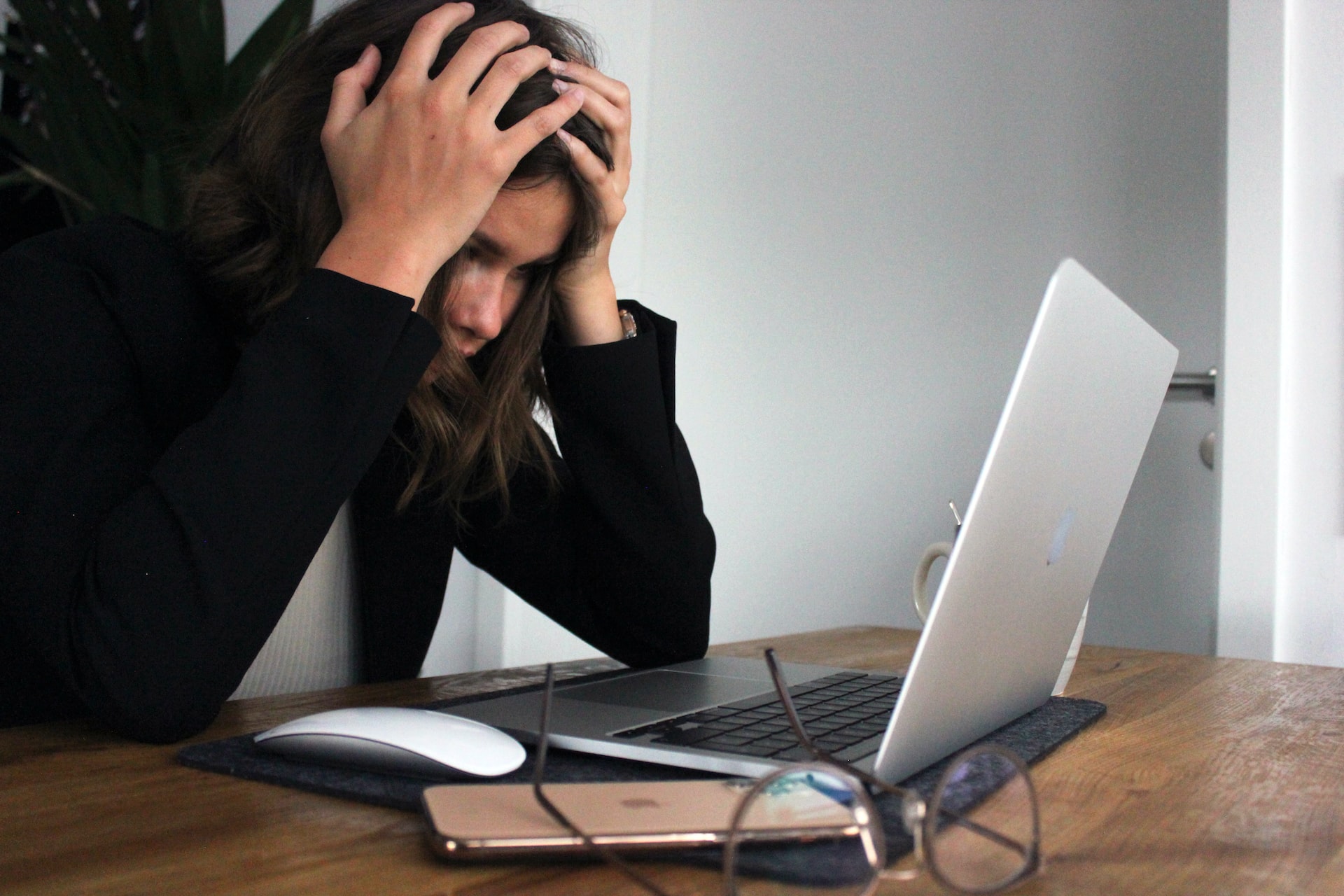First published on Wednesday, Jun 24, 2020
Last updated on Wednesday, Jun 19, 2024
We all deal with stress from time to time. But for some employees, workplace stress can often become overwhelming and may lead to serious health issues, such as anxiety and depression.
Simple things like an increased workload, or company changes can cause excessive pressure on someone's mental health. As an employer, you have a duty of care to all your employees by creating a safe working environment.
In this guide, we'll discuss what workplace stress is, what causes stress at work, and how to successfully manage it within your business.
What is Workplace Stress?
Workplace stress is when work pressure becomes too much for an employee. This form of stress can have a negative impact on an employee's physical and mental health.
The Health and Safety Executive (HSE) defines work-related stress as 'the adverse reaction people have to excessive pressure of work or other types of demands placed on them'.
Excessive levels of stress at work is a major concern. If left untreated, it can increase the risk of developing a serious physical or mental health problem. This will lead to a dip in employee morale, productivity, and quality of work.
It's typically difficult to identify as many employees may not admit to feeling stressed. As an employer, it's important you understand what can cause your staff to feel this way.
What are the Causes of Work-Related Stress?
Different causes can make different people feel stressed. The Healthy and Safety Executive (HSE) has listed six main areas of work that can increase stress levels which you need to be aware of. These include:
- Demand: The demands a job can bring. For example, long hours, shift work, increased workload or tight deadlines.
- Control: How much control someone has over their job. For example, the way someone does their job.
- Support: Not receiving enough support. For example, the number of resources available to carry out a job or support from management.
- Relationships: Developing good relationships with colleagues. For example, having a difficult relationship with a colleague can lead to workplace harassment or bullying.
- Role: Being unclear about a job role and its expectations. For example, being given a project without sufficient instruction.
- Change: A change in job satisfaction or the working environment. For example, a change in team structure or management.
However, there are other common causes of work stress. Such as problems in personal life, or a difficult work-life balance.
Does Workplace Stress Affect Physical and Mental Health?
Stress at work can lead to serious physical and mental ill health. It greatly increases the risk of mental health conditions such as anxiety and depression.
To fully understand how serious stress is for your company and your employees, you need to be aware of its physical and physiological symptoms.
Physiological Symptoms of Workplace Stress
Mental health at work is a major issue. So as an employer, you need to know what to look out for in your employees to tackle it head-on. Below are common mental symptoms of stress in the workplace that your employees may be experiencing.
Absenteeism or Lateness
One of the major signs of work-related stress is an increase in unauthorised absences or regularly arriving late to work.
If this is the case for an employee, they could be suffering from stress. Especially if they are usually on time or don't have many sick days throughout the year. Ensure you keep an eye on attendance records to try and spot any increased absence patterns.
Emotional Signs
There are many emotional signs which could be a product of feeling stressed at work. For example, an employee who is suffering from work-related stress may stop feeling motivated or committed to their job.
Other common emotional or mental health signs of work-related stress are:
- Mood swings.
- Finding it hard to concentrate during tasks.
- Feeling anxious or depressed.
- Losing confidence in themselves or the job.
- Snapping at colleagues.
- Feeling overwhelmed or unable to switch off from work.
- Becoming more emotional.
As an employer, you need to make yourself aware of what to look out for in your employees if they are struggling to cope. This includes the physical signs of work-related stress.
Physical Symptoms of Workplace Stress
Stress at work can affect physical health as well as mental health. You need to know the physical signs to look out for that may cause stress.
Below are common physical symptoms of stress in the workplace.
A Decrease in Employee Performance
A common symptom of stress is a clear dip in an employee's output and performance. If you notice a previously high-performing worker struggling to keep up with deadlines or workloads, they may be stressed.
Ensure you keep up to date with weekly, monthly, and quarterly outputs to spot any patterns. Spotting a dip in performance early can help an employee manage stress levels.
Physical Signs
There are many physical symptoms that could be caused by work related stress. For example, constant tiredness or having no energy which could lead to a serious drop in morale and productivity.
Other physical signs are:
- Heart disease.
- Constipation or diarrhoea, leading to increased visits to the toilet.
- Muscle aches or pains.
- Feeling sick or having a headache.
- Rapidly gaining or losing weight.
As well as physical and mental symptoms, there are also behavioural changes that can be a sign of stress.
Behavioural Symptoms of Workplace Stress
If an employee is stressed it can affect the way they regularly behave. For example:
- Eating more or less than usual.
- Having trouble sleeping or not sleeping at all.
- Isolating themselves from others and becoming withdrawn.
- Drinking alcohol, smoking, or taking drugs as a way to deal with stress.
Excessive drinking, smoking, or drug taking can lead to more serious health issues further down the line.

What are the Laws for Stress in the Workplace?
Under UK health & safety legislation, you have a duty of care to all your employees. This means you have a responsibility to protect employees' well-being from stress at work.
This includes providing your staff with the correct amount of paid time off under the Working Time Regulations 1998. Not proving the correct amount of breaks can increase workloads, which can lead to stress.
Role of the Health and Safety Executive (HSE)
The role of the HSE is to secure the health, safety, and welfare of employees at work.
Their role as a regulator means they offer guidance and awareness to employees who suffer from stress. They also provide advice to employers to help manage stress at work.
How Should Employers Manage Workplace Stress
Employers play a huge part in helping to reduce stress in the workplace. There are many things you can do to help employees who are suffering from stress. As well as preventing other staff from feeling the same way.
Create a Framework to Manage Stress
As a business owner, you should create a clear and concise company framework to manage stress at work. This framework will help to priortise mental health and help employees in avoiding becoming stressed.
You should make sure you carry out the following:
- Hold training sessions to help develop skills to deal with stressful situations.
- Hold focus groups to encourage an open culture and allow employees to develop good relationships. This will allow employees to discuss potentially stressful situations and take advice from colleagues.
- Encourage coping techniques that can be used to relieve stress. Such as breathing exercises or a walk away from their workstation, and spending time outside. Short breaks throughout their working day can go a long way in reducing stress.
Creating a framework can lead to employees feeling more physically and mentally healthy at work. Meaning morale, productivity, and quality of work are boosted.
Work on Prevention
To ensure work-related stress in your company stays at a minimum, you should work on ways to best prevent stress.
There are numerous things you can do to identify and eradicate the main risks of stress. For example:
- Carrying out a stress risk assessment.
- Provide job training and ongoing support to employees.
- Increase training and support during periods of change for the business or the working environment.
- Ensure all managers are trained to identify potential causes of work-related stress.
Discuss Extra Workloads with Employees
You should never pressure any employees to take on extra workloads. If you're thinking of handing a big project or piece of work to an employee, discuss it with them before handing it over.
During the meeting explain what is expected of them, but allow them to ask any questions they have. This will ensure they feel comfortable about the task moving forward. If an employee feels pressure to accept any work they're given, they may begin to show signs of work-related stress.
Hold Regular One-to-One Meetings
As an employer, you should hold regular meetings with all your employees. These meetings can allow them to raise any concerns they have regarding work pressure, deadlines, or any other issues that could cause stress.
These meetings can strengthen the working relationship, meaning if an employee is feeling stressed they may be more comfortable talking about it.
Encourage Employees to Speak With Their Family
Explain to the employee the benefits of talking to friends and family if they're feeling stressed. These people know them best, and having a strong and supportive network is vital in managing stress.
Talking is often the first step in tackling a mental health problem as the signs aren't always obvious. But make them aware you'll lend an ear if they don't want to speak with their family.
How to Treat Work-Related Stress
Some employees will cope with stress at work better than others. As an employer, you must have different options to offer your staff if they are struggling to cope with work pressure. For example:
- Creating an employee assistance programme.
- Offering your employees flexible working opportunities to improve their work-life balance.
- Making your employees aware of a counselling service. Often speaking with an objective person can help in a big way.
- Encouraging your employees to take a holiday. Taking a holiday can help them relax, recharge and gain perspective on their working life.
Get Advice on Stress with BrightHR
As an employer, the health and well-being of your employees should be one of your top priorities. If left unnoticed it can cause serious mental and physical health problems in the future, so you must handle this issue with care.
There are many coping techniques to support your employees. Taking regular breaks or simply talking about the issues can reduce excessive levels of stress and improve your staff's life.
Failure to manage stress correctly may lead to disciplinary actions or discrimination claims against your business.
BrightHR can help you manage stress with our BrightAdvice helpline. Don’t hesitate to call us if you need any help with tackling work-related stress.
Book a free demo today or give us a call on 08007832806
Have a question?
Ask away, we’ve got lightning fast answers for UK business owners and employers powered by qualified experts.









